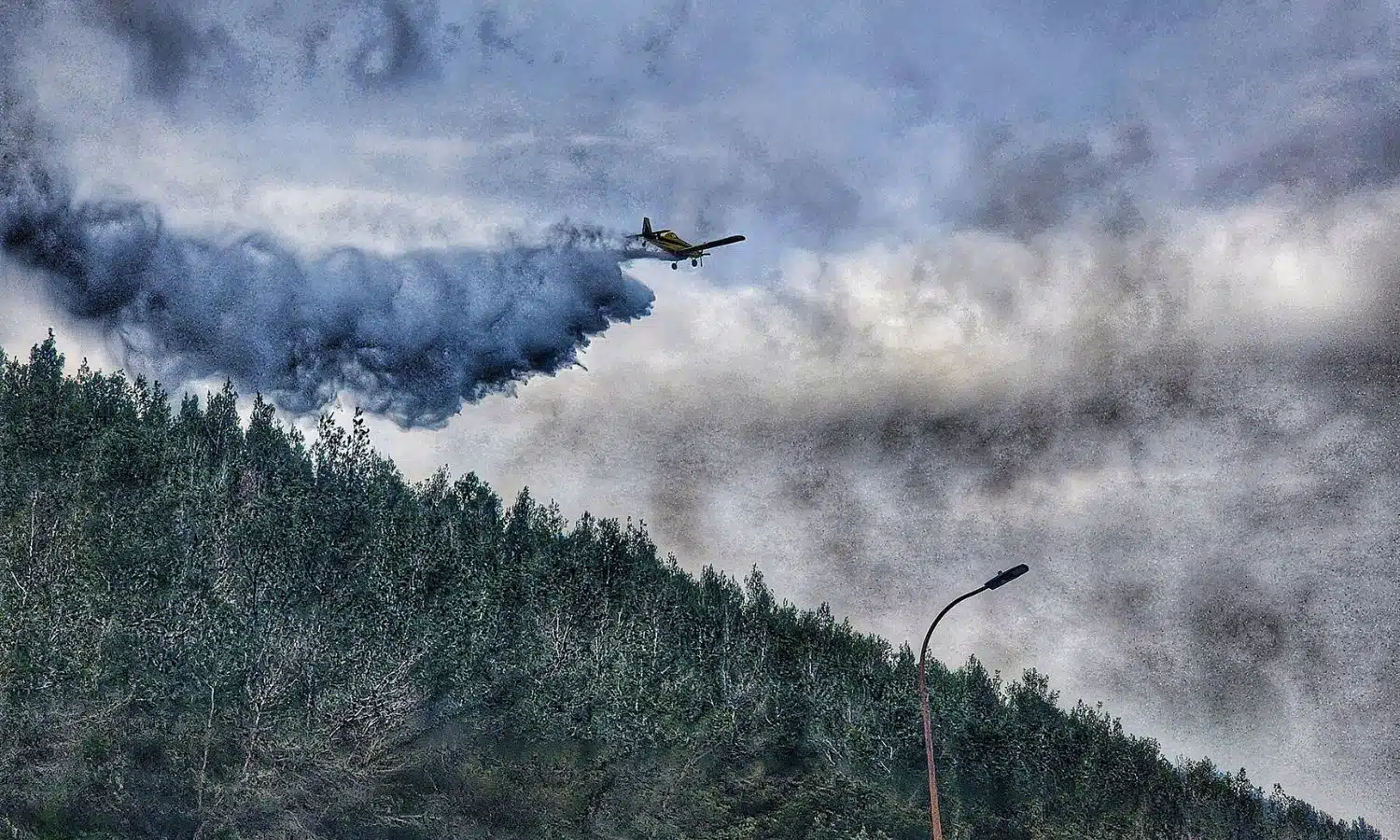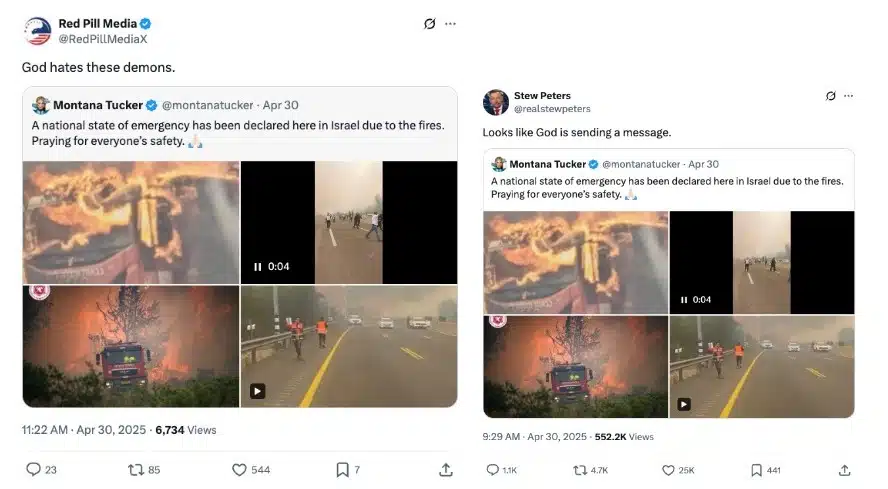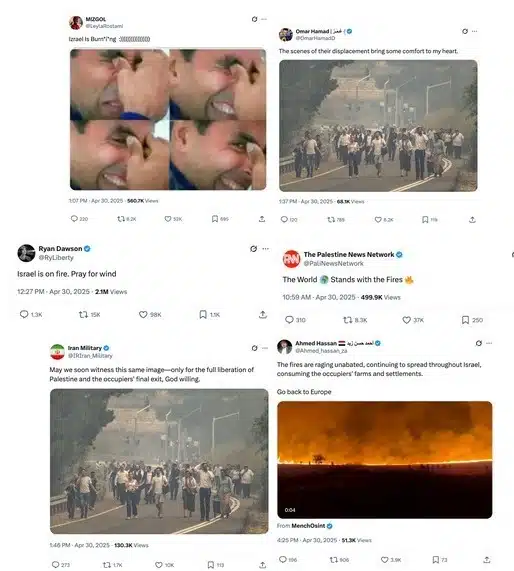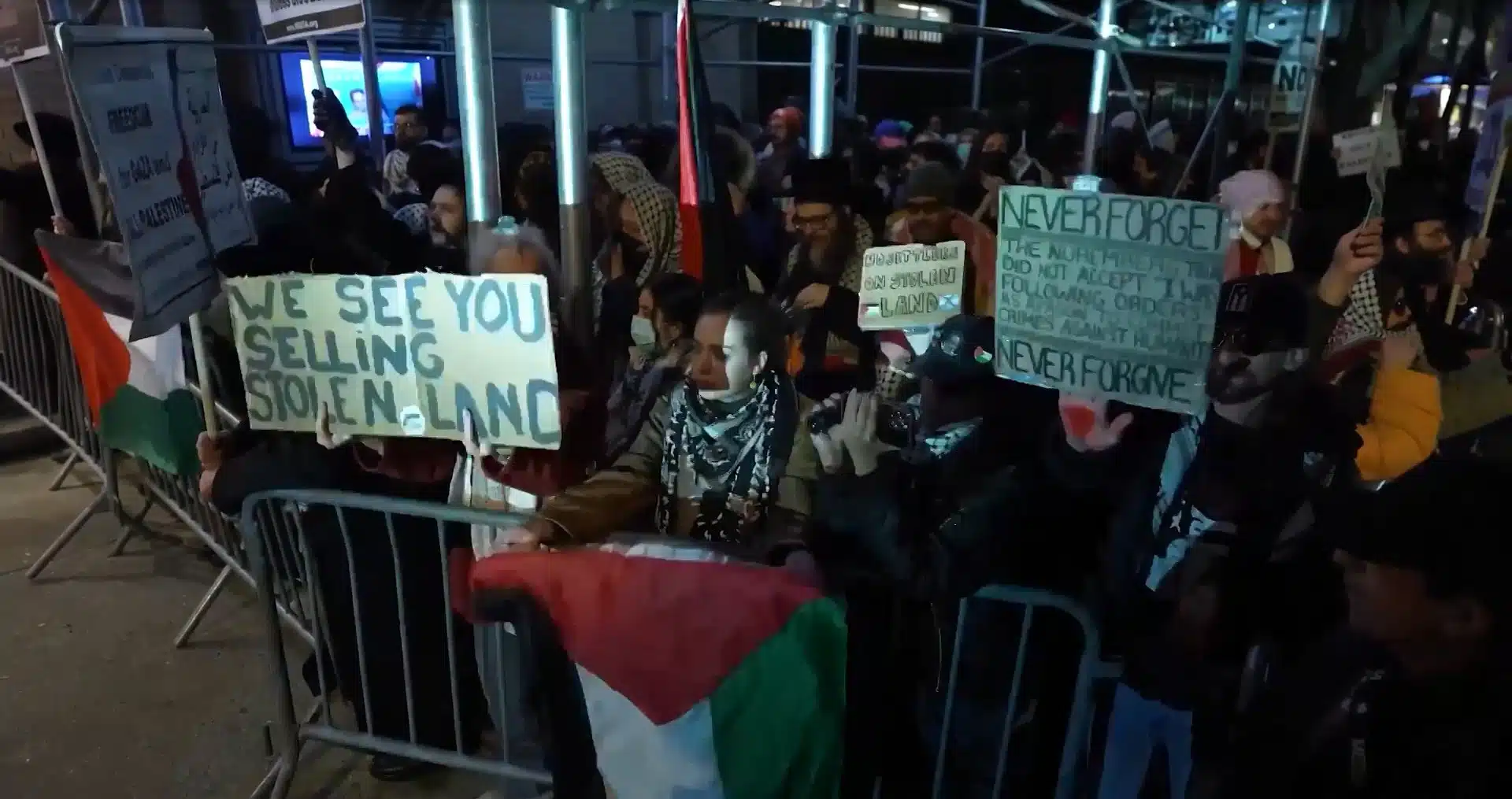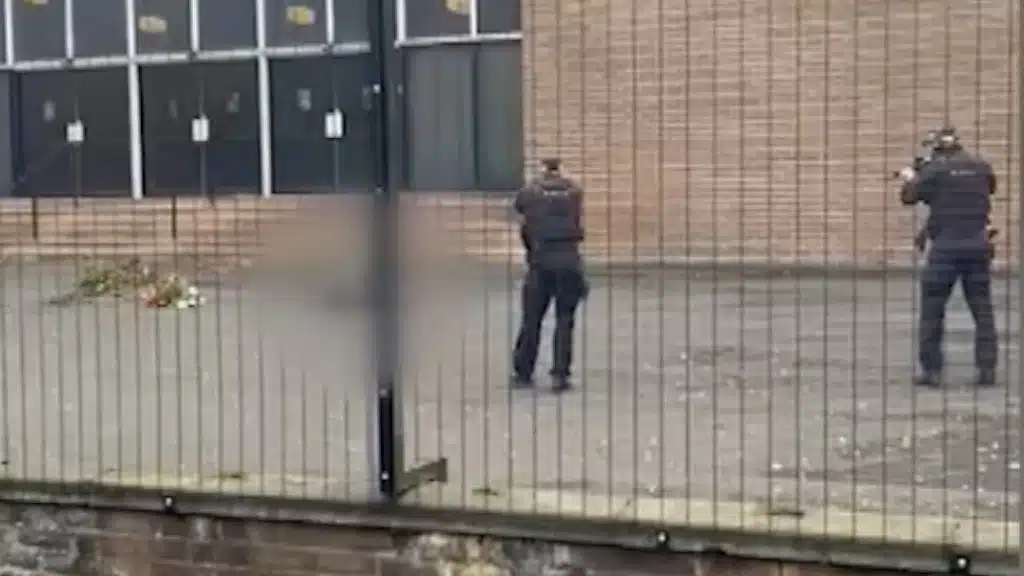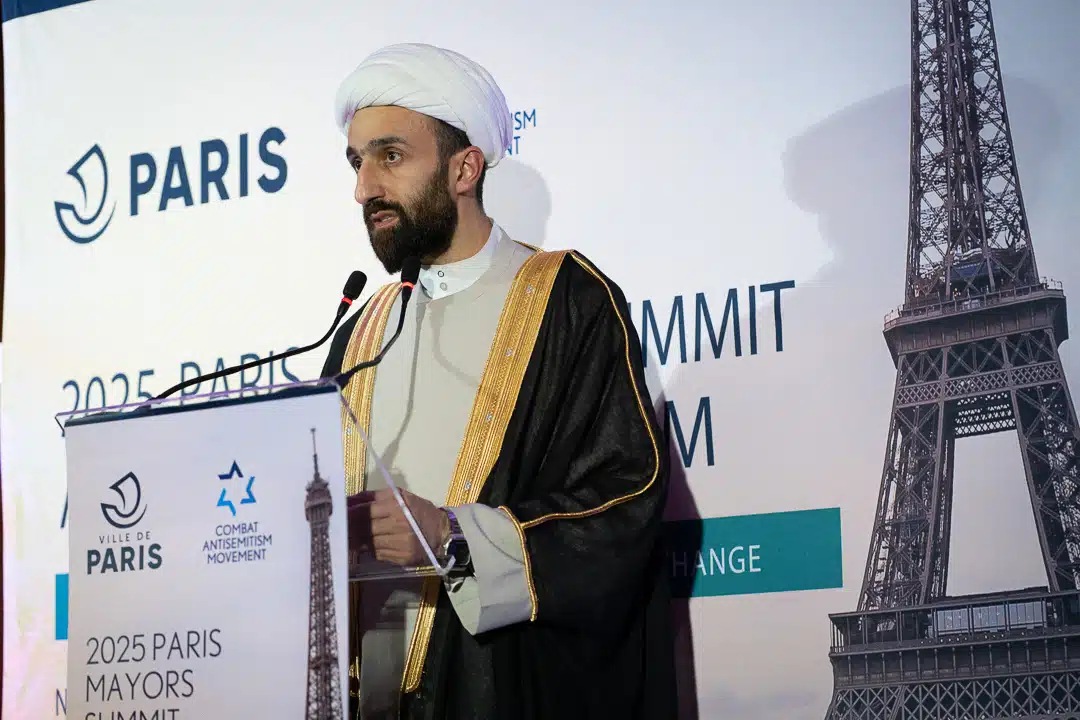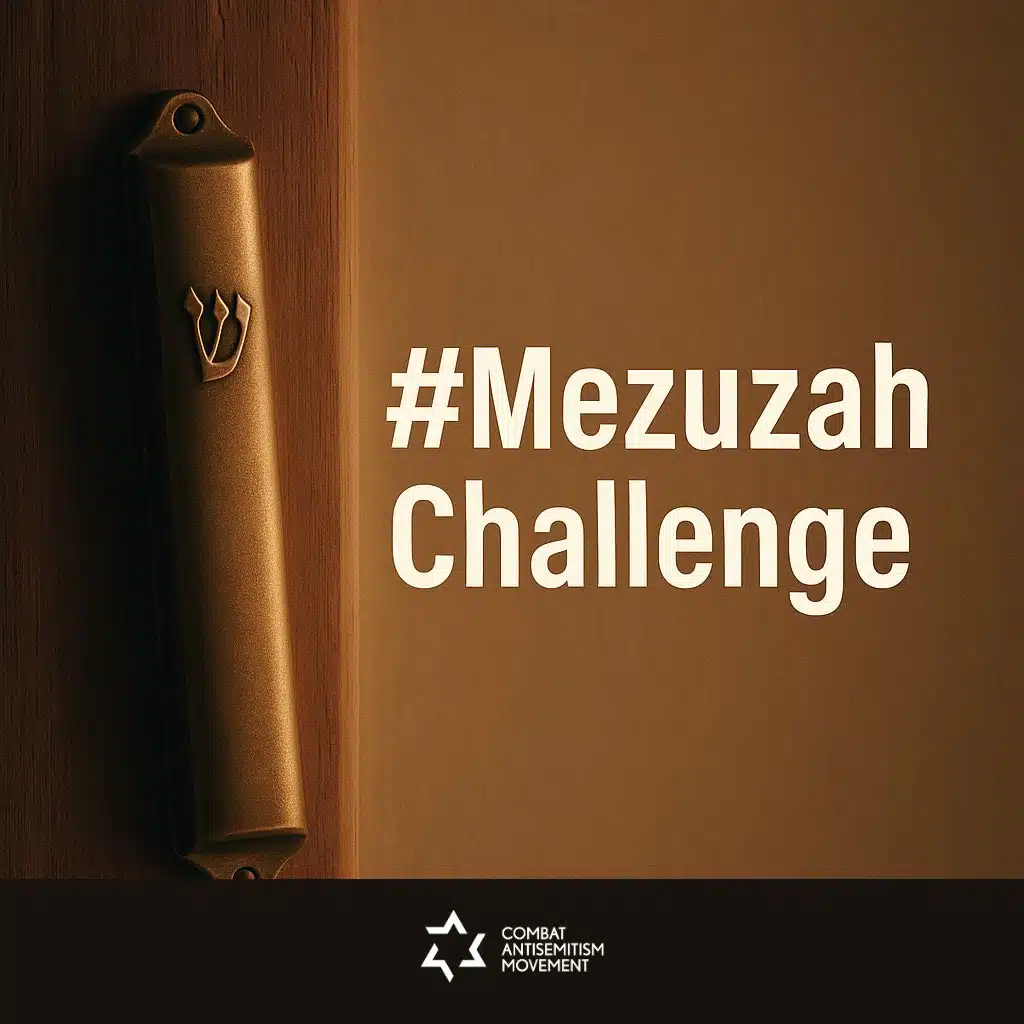|
Getting your Trinity Audio player ready...
|
The following analysis was authored by the Antisemitism Research Center (ARC) by CAM:
On April 30, 2025, just as Yom HaAtzmaut, Israel’s national Independence Day, was getting underway, the country was ravaged by widespread wildfires. Celebrations were canceled, ceremonies postponed, and residents forced to evacuate. However, rather than prompting expressions of solidarity, the blazes unleashed a torrent of online antisemitism – fueled by conspiracy theories, victim-blaming, and perverse joy in Israeli suffering.
Within hours of the fires breaking out, extremist voices flooded social media, cheering Israeli misfortune and offering a range of distorted narratives. Some framed the fires as divine punishment for Israel’s treatment of the Palestinians, calling Israelis “demons.” Others pointed to so-called “settler-colonial” tree-planting practices to justify incendiary statements like “May every settler burn.” This toxic mix of schadenfreude and hate – driven by far-right, far-left, and Islamist ideologies alike – highlighted the adaptable and ideologically unbound nature of modern antisemitism.
Turning Victims Into Villains: A Classic Antisemitic Tactic
To portray Jews or Israelis as victims is to cast them as sympathetic – and for antisemites, that is intolerable. Instead, they rewrite reality, recasting innocent Israelis as the aggressors in order to justify or excuse their suffering.
This tactic was on full display following the Jerusalem fires, as social media users promoted the claim that the disaster was caused by Israeli “colonial” tree-planting practices through the Jewish National Fund (JNF). According to data from the social media analytics firm Cyabra, the claim that Israeli “settler-colonial” tree-planting practices caused the fires appeared in 321 posts – out of a total of 18,045 posts and comments made by 15,048 unique profiles discussing the fires. These 321 posts alone generated more than 217,000 interactions and reached an estimated 285 million views.
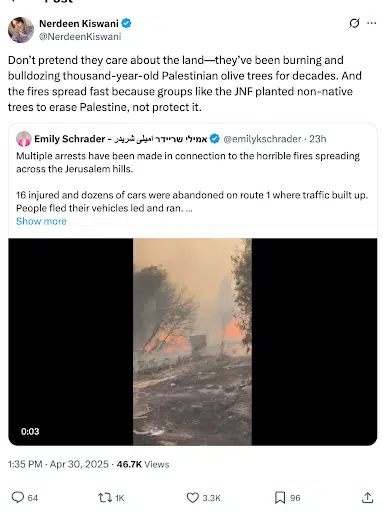
Blaming Jews for their own suffering is a longstanding antisemitic pattern. One of its most prominent 20th-century examples came from Father Charles Coughlin, a popular Catholic priest and radio broadcaster in the United States. At the height of his influence in the 1930s, Coughlin reached millions of listeners each week with sermons that often veered into conspiratorial antisemitism. Just days after the Nazi-led Kristallnacht pogrom in November 1938, Coughlin used his national platform to justify the violence as retribution for what he described as Jewish responsibility for the alleged murder of 20 million Christians in Russia and the destruction of $40 billion in property by “the Lenins and Trotskys,…atheistic Jews and Gentiles.”
During the rampage, members of the Nazi Party, Hitler Youth, and Sturmabteilung (SA) destroyed or damaged over 7,500 Jewish-owned businesses and homes, burned more than 1,400 synagogues, killed at least 91 Jews (with later research indicating the total death toll may have reached several hundred), and imprisoned 30,000 Jewish men in concentration camps. Yet Coughlin portrayed this atrocity not as a horror to be condemned, but as a justified backlash – an inversion of victimhood that echoes in today’s antisemitic responses to Israeli suffering.
Similarly, in November 2024, anti-Israel commentators and media outlets blamed Maccabi Tel Aviv fans for a premeditated pogrom against them – whitewashing the fact that the perpetrators themselves openly described their rampage as a “Jew hunt.” (See the example below.)
Whether in response to natural disasters or premeditated violence, this pattern persists: Jewish suffering is twisted into justification for more hate. The concern for environmental policy is merely a pretext – one user’s post stating “May every settler burn,” alongside a critique of planting “European trees,” leaves no doubt about the real motivation behind such rhetoric.
Invoking Divine Punishment
When antisemites can’t plausibly blame Jews for their own suffering, they often turn to religious justification. According to Cyabra, 1,375 posts about the fires invoked divine punishment – generating more than 217,000 interactions and reaching over 316 million viewers.
Throughout history, Jewish suffering has often been interpreted through a religious lens. In Christianity, the notion that Jews were collectively responsible for the death of Jesus fueled nearly two thousand years of persecution. Although repudiated by most mainstream Christian denominations in the 20th century, this belief continues among fringe Christian fundamentalists, white supremacists, and neo-Nazi groups – some of whom celebrated the Jerusalem fires as divine retribution.
The two screenshots below depict far-right accounts invoking divine punishment as they gloat over the fires in Israel. (One of the users, Peters, previously claimed that “the Jews killed Jesus Christ.”)
In Islam, antisemitic interpretations of Quranic texts can be traced back to seventh-century conflicts between Muhammad and Jewish tribes in the Arabian Peninsula. From these events emerged a theological view portraying Jews as intractable, deceitful, and divinely cursed – described in some verses as prophet-killers, pigs, and perpetual enemies of God. Radical Islamists continue to propagate this strain of Islamic antisemitism, whether through the antisemitic chant, “Khaybar Khaybar ya yahud” or the Houthis’ slogan, “Curse the Jews.”
Unbridled, Unmasked Antisemitism
Amid hundreds of millions of views and interactions across social media, the posts that garnered the most engagement were not those offering ideological or religious justifications – they were the ones that simply celebrated Israeli suffering. According to Cyabra, 1,863 such posts reveled in the damage, expressed open joy, and even voiced solidarity with the fires themselves. Many called for more destruction, greater pain, and the complete eradication of Israel and its people. Together, these posts generated more than 378,000 interactions and reached an estimated 543 million users.
This is not “criticism of Israel.” It is unfiltered, genocidal antisemitism.
Conclusion
Antisemitism is not a relic of the past. It mutates, adapts, and finds new forms of expression. Today, social media amplifies that hate to a global scale in real time.
The reaction to the Jerusalem fires was not an isolated case – it was part of a broader pattern of dehumanizing rhetoric that has fueled violence against Jews throughout history. It was the same rhetoric that enabled the October 7, 2023 Hamas-led massacre, during which terrorists murdered and kidnapped civilians across southern Israel. In the wake of the fires, Hamas encouraged followers to “burn whatever you can of groves, forests, and settler homes.”
The lesson is clear: genocidal hatred does not begin with bullets or bombs. It begins with words – words that deny humanity, twist truth, and turn tragedy into justification for violence. History leaves no room for doubt: hatred ignored does not disappear – it returns, louder, bolder, and more violent.

